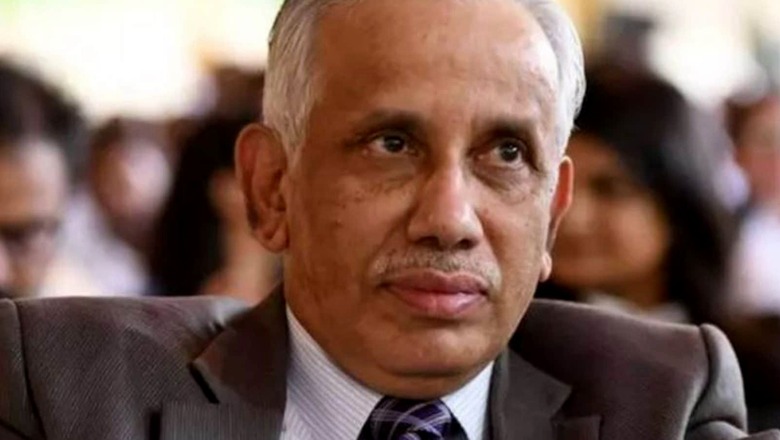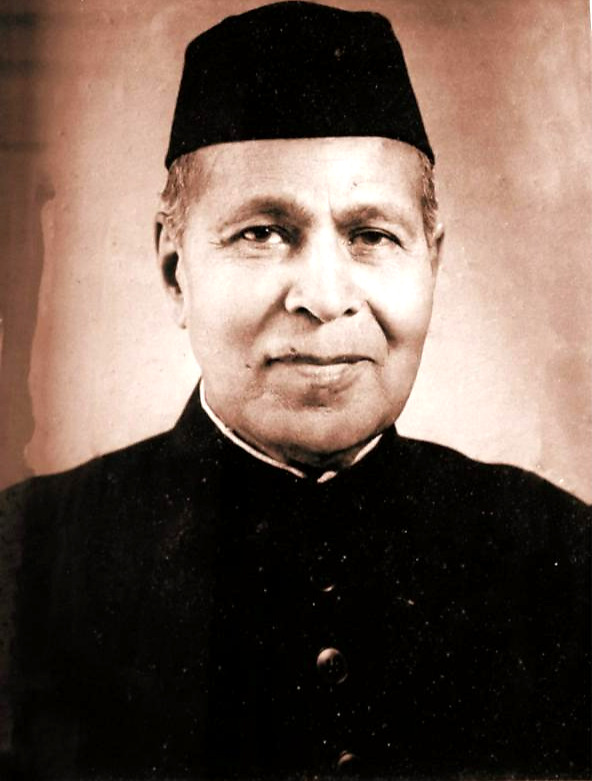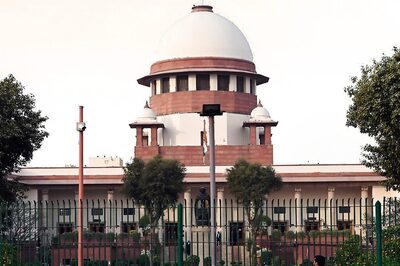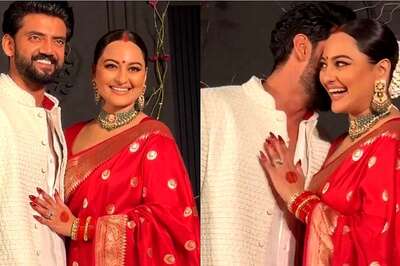
views
The decision of the Narendra Modi government to appoint Justice S Abdul Nazeer the governor of Andhra Pradesh about a month after he retired from the Supreme Court on January 4 has set off a political storm. Most of the opposition parties and the NGO brigade perpetually against Modi have questioned the appointment, saying this raises doubts about the fairness and independence of the judiciary. No opposition political party or leader wants to be left behind in attacking the appointment of Justice Nazeer: be it the Congress, SP, TMC, DMK, YSR Congress, or even AIMIM.
Congress opposing Justice Nazeer’s appointment
The Congress is the most vocal and dogged in opposing this appointment. From Congress’s communication cell chief Jairam Ramesh to Raashid Alvi. Alvi has even said that Nazeer’s appointment has lowered people’s confidence in the judiciary. Most of the reactions of opposition leaders are on the same lines; they have even hinted that Justice Nazeer has been rewarded for giving decisions in favour of the government in Ram Mandir and other cases. Similar accusations had been hurled when former Chief Justice of India Ranjan Gogoi was nominated to the Rajya Sabha after his retirement from the apex court.
Opposition forgot case of Justice Fathima Beevi
But the opposition leaders and people from the NGO brigade forget that in the past too retired judges were made governors. The same kind of hue and cry was raised when the Modi government appointed retired Justice P Sathasivam as Kerala’s governor in September 2014. Not only the Congress, but other non-BJP governments too have appointed retired judges as governors. The HD Deve Gowda government appointed Justice M Fathima Beevi governor of Tamil Nadu on January 25, 1997, after she retired from the Supreme Court in 1992. She continued on the post till July 3, 2001, quitting only after a row over the arrest of former Tamil Nadu chief minister M Karunanidhi when Atal Bihari Vajpayee was prime minister.
Congress made Justice Fathima Beevi member of NHRC
The year after her retirement from the Supreme Court on April 29, 1992, Justice Fathima Beevi was made a member of the National Human Rights Commission, on November 3, 1993, by the then Prime Minister Narasimha Rao, and she continued in the post till January 24, 1997, a day before she was appointed governor. In 1993, the National Human Rights Commission was established and Justice Ranganath Misra was its chairman. Justice Misra was also appointed to the NHRC by the then Congress government, in another show of charitableness, after he retired as CJI from the Supreme Court in 1991. After his tenure ended in NHRC, the Congress sent him to the Rajya Sabha in 1998. Justice Misra was only the second retired Supreme Court judge nominated to the Rajya Sabha by the Congress government after “sometimes politician, sometimes judge” Justice Baharul Islam.
As far as Justice Fathima Beevi is concerned, fortune was clearly on her side. She entered into the Judicial Services in 1958 and became a judge at the Kerala High Court in 1983. She retired at the age of 62 in April 1989. But after retirement, she was made a judge of the Supreme Court on October 6, 1989. She also became the first woman judge of the apex court.
Fathima Beevi snatched appointment in SC from Leila Seth
Justice Leila Seth has raised serious questions against Justice Fathima Beevi in her autobiography ‘On Balance’. According to Justice Seth, five months after Justice Fathima Beevi’s retirement her name was suggested for appointment in the Supreme Court, which was astonishing, and Justice Beevi had herself lobbied for it. The mother of novelist Vikram Seth, and the first woman Chief Justice of a High Court in the country, Justice Leila Seth retired as the Chief Justice of the Himachal Pradesh HC.
Fathima Beevi became first woman SC judge in Congress rule
Actually, Justice Leila Seth could have got the distinction of becoming the first woman judge of the Supreme Court, but the opportunity rather startlingly went to Justice Fathima Beevi. Justice Seth writes in her autobiography that some Supreme Court judges had confided in her that Justice Fathima Beevi had lobbied for her appointment in the SC after her retirement, as this would not only make her the first woman judge of the SC but also the first Muslim woman judge appointed to the Supreme Court of any country.
Justice Fathima Beevi made SC judge to lure Muslim votes
A political relative of Fathima Beevi had also lobbied for her appointment to the Supreme Court, saying that the move would bring Kerala’s Muslim votes to the Congress. The then union law minister B Shankaranand had also favoured her appointment. Thus, Justice Leila Seth could not be appointed to the SC as judge despite being the first woman judge of a High Court in the country, while Justice Fathima Beevi got the appointment six months after she retired from the High Court. At that time, Rajiv Gandhi was heading a Congress government at the Centre. The same Fathima Beevi went on to become the governor of Tamil Nadu with the HD Deve Gowda-led United Front government at the Centre.

But the case of Justice Fazl Ali is no less interesting. Justice Ali was appointed governor of Odisha by India’s first prime minister Pandit Jawaharlal Nehru, with the Congress in power at the Centre. Be it Justice Fathima Beevi, Justice Sathasivam, or Justice Abdul Nazeer, they were all made governors after a few months to a year or so of retiring from the Supreme Court.
It was Nehru who appointed Justice Fazl Ali as governor
Nehru had announced the appointment of Justice Fazl Ali as Odisha’s governor when he was yet to retire from the Supreme Court, and no questions were raised at the time. And who was going to escalate the matter anyway? The Congress was the sole power centre, the opposition was almost non-existent, and the intellectuals of the time were romancing Nehru.
Since beginning, Fazl Ali was Nehru’s favourite
Justice Fazl Ali was from Uttar Pradesh, which is also the home state of Congress leader Rashid Alvi. Justice Ali belonged to a famous family in Varanasi. His father was also an advocate, and his son Justice SM Fazl Ali also became a judge of the Supreme Court later. Fazl Ali wanted to be in the ICS but could not pass the entrance exam, so he got a degree in law from London and started his career as a lawyer in Chhapra, Bihar. Later, he began practising in Patna High Court and in April 1928, he was appointed a judge in the Patna HC, at the age of 41. In 1943, he became the Chief Justice of the Patna High Court, becoming the first Indian to be appointed to the post. In 1946, Justice Fazl Ali was made the head of the commission appointed to investigate the famous Royal Indian Navy mutiny in Mumbai.
Justice Fazl Ali also assigned to investigate Kolkata riots
As per the prevailing rules, Justice Fazl Ali was to retire in September 1946, but he was given a one-year extension by the central government. By September 2, 1946, Nehru had become vice president of the executive council of the Viceroy. After getting the extension, Justice Fazl Ali was also made the head of the commission investigating the communal riots of Kolkata in September 1946. These riots broke out after the Muslim League announced its Direct Action plan for the creation of Pakistan on August 16, 1946, with loot, rapes, and killings, to which there was later a reaction from the Hindu side. These communal riots were so devastating that they have been labelled the ‘Great Calcutta Killings’. The mayhem continued for three days and around 4,000 people were killed and more than 1 lakh people were left homeless.
Nehru sent Fazl Ali to represent India in UN General Assembly
Fazl Ali was brought into the Federal Court from the Patna High Court on June 9, 1947. Before Independence, the Federal Court was the highest court of the land. While he was a judge of the Federal Court, Fazl Ali was sent to New York as a member of the Indian delegation to the second meeting of the United Nations General Assembly in September 1947 by Nehru who had become the Prime Minister of India on August 15, 1947. At that time, the national capital was in the grip of communal riots.
The first Attorney General for India eminent lawyer Motilal Setalvad has said in his biography ‘My Life’ that when in September 1947, the Indian delegation was leaving for New York, Delhi was witnessing a wave of communal violence. In such a situation, Fazl Ali was brought to the Delhi airport dressed as a Hindu so he would not be attacked on the way. In that meeting of the UN General Assembly, Fazl Ali was also chosen as the head of the fifth committee of the body.
Fazl Ali was one of the first judges of Supreme Court
The Federal Court became the Supreme Court after January 26, 1950, when independent India’s constitution came into force. Fazl Ali became one of the first judges of the Supreme Court, as he was the second person to take oath after Chief Justice Hiralal Kania. Born on September 19, 1886, Justice Fazl Ali retired at the age of 65 on September 19, 1951. But his retirement was short. Using Article 128 of the Constitution, the then Chief Justice of the Supreme Court, Justice Kania, brought him back to the SC about a month after his retirement, and he resumed work on October 15, 1951.
In May 1952, when Justice Ali was still working as a Supreme Court judge, Nehru announced his appointment as governor of Odisha. The Supreme Court summer vacations were approaching and, as per Nehru’s wishes, Justice Fazl Ali resigned from his post on May 30, 1952, and within eight days he assumed charge as governor of Odisha, on June 7, 1952.
Nehru’s decision faced criticism
The appointment of Fazl Ali as governor attracted criticism in legal circles, even if it did not raise any political heat and dust. The first Attorney General for India Motilal Setalvad, who had stood with Jawaharlal Nehru during his run-ins with the first President of India Rajendra Prasad, was also perturbed by the PM’s decision. Setalvad has mentioned this episode in detail in his autobiography. He wrote that it was natural that this appointment was facing criticism. As per him, this appointment had raised the issue of constitutional morality, as a person who was part of the Judiciary by being a judge of the Supreme Court, had been appointed governor and thus been made part of the Executive. Setalvad has said that this decision of Nehru went against the healthy tradition of maintaining a respectable distance between the Judiciary and the Executive. He has said that appointing a retired Supreme Court judge as governor is an attack on the independence of the Judiciary. Setalvad did not question the ability of Justice Fazl Ali, but he was against his appointment as governor when he was still a judge of the Supreme Court.
Nehru had his way
The criticism of this appointment did not affect Nehru. Overruling the objections of legal luminaries like Setalvad and others, Nehru appointed Fazl Ali as governor of Odisha. Fazl Ali, who had an experience of 24 years as a judge in the High Court and Supreme Court, accepted this decision and remained the governor of Odisha till February 9, 1954.
Fazl Ali as chairman of States Reorganisation Commission
Fazl Ali continued to be Nehru’s favourite. When a commission was formed to reorganise the states on a linguistic basis, Fazl Ali was made its chairman. He was asked to leave his post as the governor of Odisha and take on the chairmanship of the States Reorganisation Commission in 1954. This was a very important appointment, considering the significance of this commission at the time. In the role of the head of this commission, Fazl Ali stood somewhere between the Executive and the Judiciary. The question of fairness was in many people’s minds. The commission was to decide the boundaries of the newly organised states and it was feared that the panel’s decisions would bear Nehru’s stamp. The other members of this commission were KM Panikkar and Hridaynath Kunzru.
Nehru made Fazl Ali governor again, this time of Assam
The commission submitted its report in September 1955 and the Nehru government accepted the recommendations with some minor amendments. After this, on May 15, 1956, Nehru entrusted Fazl Ali with another assignment. This time he was sent to Assam as governor. At that time Assam also included many other modern-day states, such as NEFA. This is the same NEFA, which became Arunachal Pradesh after India’s war with China in 1962. Fazl Ali remained governor of Assam till his death on August 22, 1959, due to cancer.
Stance of opposition is contradictory
Today, Rashid Alvi and other Congress leaders would not like to discuss the episode of Fazl Ali who was a favourite of Nehru and was appointed governor when he was still a judge. But they are angry over the appointment of Justice Nazeer as governor of Andhra Pradesh about a month after he retired. It is obvious that the Congress and its leaders would not like to recall the episode of Fathima Beevi either. It was Justice Leila Seth who deserved to be appointed to the Supreme Court had vote bank politics not come into play. Later, the United Front government made her the governor of Tamil Nadu. The opposition which accuses Modi of neglecting Muslims is now criticising the appointment of Justice Nazeer. This contradictory stance of the opposition is beyond comprehension. Actually, in politics, there is no permanent position. This episode is also an example of that. If you do it, it is moral, and when your rival does it, it becomes immoral. But this criticism by the opposition is not going to make any difference to the Modi government, nor, one suspects, to Justice Nazeer.
Read all the Latest Opinions here




















Comments
0 comment